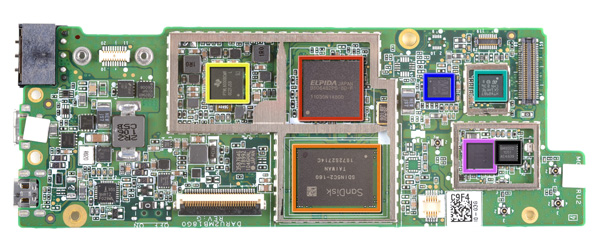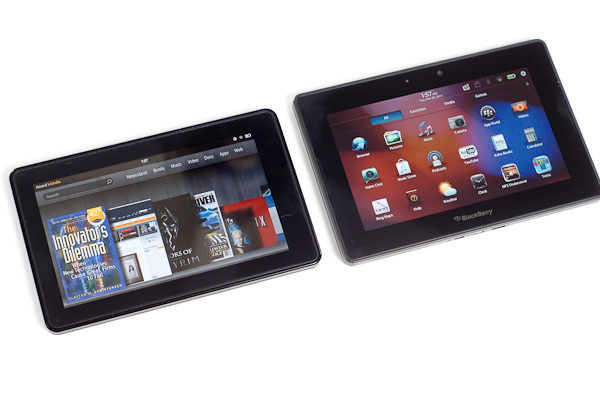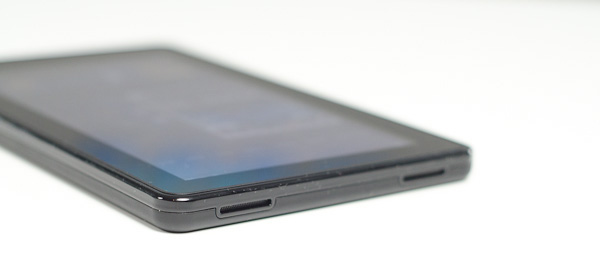Amazon Kindle Fire Review
by Anand Lal Shimpi & Vivek Gowri on November 29, 2011 3:31 AM EST- Posted in
- Tablets
- Mobile
- Amazon
- Kindle Fire
- Kindle
Mario Twins
Rumor had it that in order to save time (and likely cost) in bringing the Fire to market, Amazon had opted to use the same design as the BlackBerry PlayBook courtesy of the ODM that made both: Quanta.
ODMs like Quanta will build anything you want or they'll do slight modifications to an existing design to suit your needs. The idea is you don't need to be an expert at everything. If your differentiation is primarily software and you just need a fast hardware platform, Quanta (or Pegasus or Foxconn, etc...) will give you that and let you roll your own software stack on top of it. It's not all that uncommon in the industry. This is actually how companies like Marvell work in the SSD space as well. They'll give you the hardware, but the most successful drive makers simply use the Marvell hardware as a base platform - they all write their own firmware.
Aesthetically, the Kindle Fire looks a lot like the PlayBook. The dimensions, screen size/resolution and even build quality are eerily reminiscent of one another although the PlayBook is tangibly larger. Both tablets have a large screen bezel (the PB's is bigger) and soft touch plastic on the back. The power/lock button on the Kindle Fire is also quite similar to what's used on the PlayBook. It's in a different location and is much easier to actuate but it's clear that even the buttons came from a similar parts bin.
A look inside both devices shows a different arrangement of components and a different layout on each motherboard. Our own Brian Klug spotted a curious reference on each board however: the PlayBook's board is labeled Rev. G while the Fire's board is labeled Rev. F. Is it possible that the two boards are simply different revisions of one another?

Image Courtesy iFixit - Kindle Fire Motherboard

Image Courtesy iFixit - Kindle Fire Motherboard
Either way it's clear Amazon departed from its usual unique design approach with the Kindle Fire. While previous Kindles were fairly recognizable among a sea of devices, the Kindle Fire looks and feels like a PlayBook. In fact, when it's off and sitting on your desk, you'd be hard pressed to tell that it was something made by Amazon. The large 'kindle' lettering on the back was likely designed to address this brand identity issue, but it really was the only thing Amazon could have done given the generic looking platform.
Looks aren't a major concern of mine but I do wonder what we can conclude from this. Either the Kindle Fire was a rushed project to catch the 2011 holiday shopping season or it's a sign that value tablets can't look very special, or perhaps both?
Simplicity in Hardware
Despite the physical similarities to the PlayBook, Amazon whittled down the number of buttons on the Kindle Fire to just one: power/lock. Volume controls are entirely in software, and to be honest I don't miss the physical buttons. As this isn't a smartphone, I don't need to worry about quickly silencing a ring or increasing the volume of a call. The tradeoff here makes sense.
As I mentioned before, the round power/lock button is easy to actuate. The bigger problem is the button's location: at the bottom of the Kindle Fire. On the bright side it does keep the button out of your way when you're reading, it just happens to be in the exact opposite location of where years of using modern smartphones/tablets have taught us to expect it. Then again, an oddly placed power/lock button isn't too big of a deal when you've got a configurable software screen lock.
A 1/8-inch headphone jack and micro USB port keep the power/lock button company. Amazon doesn't ship the fire with a micro USB cable, instead you just get a power brick with a micro USB end for charging the Fire. To Amazon's credit, to use the Fire as a Kindle you never need to hook it up to your Mac or PC. A standard USB cable is only really needed for getting your own music, videos or apps onto the device.
There are a pair of stereo speakers on the opposite end of the device. The volume control feels non-linear and the speakers get loud enough to make their position a bit awkward. Hearing loud noises from one side of the device and not the other isn't really desirable, particularly since you'll likely be watching movies on the Kindle Fire in landscape mode.













70 Comments
View All Comments
Reflex - Friday, December 2, 2011 - link
So come back in February. By then we'll be on the cusp of a new generation of devices. Right now the Playbook is defficient. Its a nice set of hardware with a lacking software stack. Out of the box it simply does not do what most people want. When it does, I'm sure AT will check it out, but having them review it now is likely to simply get it slammed since it simply won't work for most people who do not already own a BB.ComputerGuy2006 - Tuesday, November 29, 2011 - link
The "final words" section says "The Kindle Fire is probably the best tablet you can buy at $199.". This is troubling.It was never explained how a $200 playbook isnt as good as the $200 kindle. Seems to me the playbook has double the ram and double the storage space. The playbook has two camera and a micro-HDMI port.
So as long RIM can keep its promise and make the playbook capable of running android apps, I dont see how the kindle can beat the playbook in ANYWAY unless you want to spend lots of money on the amazon app store.
VivekGowri - Wednesday, November 30, 2011 - link
Honestly, as tempting as the PB is at $199, RIM's utter failure to deliver features that were promised at launch even 8 months after release is pretty worrying. The lack of native email, contacts, and calendar as of December 2011 is blatantly unacceptable.doesitreallymatter - Friday, December 2, 2011 - link
It is unacceptable that those key apps are lacking. In 2 months when/if RIM delivers these apps, what will be your opinion then?As long as those apps are delivered along with the android support, I just don't see how the Fire can compete with the playbook.
I just don't understand how the conclusion has no mention of the playbook at all.
Reflex - Friday, December 2, 2011 - link
It also does not mention the Nook Tablet. Why? Because it hasn't been reviewed it. If the Playbook becomes competitive, and thats a big if honestly, I'm sure they'll take a look. But really, February? You mean almost a year after the device they give it basic functionality everyone else has shipped with from the beginning?For me, even if the Playbook was competitive, I just can't see that as a well supported platform worth me investing into the ecoysystem of.
dgburns - Wednesday, December 7, 2011 - link
Perhaps you missed the announce a while ago that RIM has dropped the Android App Player from development? So your touted "android support" isn't coming....dgburns - Wednesday, December 7, 2011 - link
The Playbook will NEVER have the ecosystem Amazon delivers with the Fire. As many commentors have implied, that's a HUGE differentiator.And to those who say the PlayBook is the better device at $199 if you own a BlackBerry smartphone already, I disagree. I've got TWO BlackBerry smartphones (different models, from two employers) and as nice as the PlayBook hardware is I STILL don't want one. Even "bridged" to a BB, the PlayBook is SO limited. Will it get better come February (or whenever RIM REALLY releases a update)? Probably, but even then it won't have the ecosystem the Fire brings.
jedivulcan - Tuesday, November 29, 2011 - link
I wish this review went into a bit more nitpicking with the display like I've seen with the other AnandTech reviews. In my experience with having two Kindle Fires, the displays are so wildly different that it's almost like looking at two different products when you have them side by side.The first Kindle Fire I received from Amazon on the day it came out had a duller backlight, some backlight bleeding when viewing older television shows on Netflix, and warmer, almost yellow colors, one or two dead pixels, and hit or miss viewing angles.
The second one I got a week later had a brighter backlight, a ton of backlight bleeding, bright dead pixels on the screen (very apparent in one location), cool blue washed out colors, and terrible viewing angles.
https://img.skitch.com/20111130-x9fq2qskte8kas62jg...
https://img.skitch.com/20111130-dm18ykeb8kud98w4t2...
Reflex - Tuesday, November 29, 2011 - link
Totally bizarre. I'm not implying you haven't seen what you've seen, but I've handled more than a dozen Fire's now and the screens have been consistent with each other and very very high quality. The one I own and took on trips got noticed repeatedly and the first comment most people had was about how nice the screen looked. Its typically the standout feature hardware wise from most people I've discussed it with.Your situation is odd to me because normally I'd suspect a bad run, but you got them a week apart. I really have no idea, but I will say it does not jive with my anecdotal experience or what I"m reading elsewhere. Anyone else see this issue?
VivekGowri - Wednesday, November 30, 2011 - link
Hmmm mine is totally fine, so was Anand's. I really, really like the display quality, though I would have preferred a more neutral colour temperature. I'm not sure why you had so many issues with the display, that's very very odd.